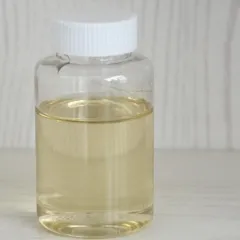- Home
- Products
- Elementary
- Boride Powder
- 3D Printing Powder
- Sulfide Powder
- Oxide Powder
- Carbide powder
- Nitride Powder
- Silicide Powder
- Hydride Powder
- Telluride Powder
- Selenide Powder
- Stearic Acid Series
- Phosphide Powder
- Nanoparticles
- Metal Alloy
- MAX Phase
- Lithium Battery Anode
- Surfactant
- Molecular sieves
- Concrete Admixtures
- Cladding of metals
- News
- Blog
- Contact
- About
Polyglyceryl-10 Laurate CAS 34406-66-1
Polyglyceryl-10 Laurate exhibits strong resistance against bacteria, mold, and yeast. When used, it can substitute sodium benzoate or potassium sorbate for preservatives to make the product healthier and more natural.
The following is a list of the most recent articles about Polyglyceryl-10 Laurate :
First, laurate is a soluble salt with the commonness of salt. It can react with acids to form corresponding acids and metal salts and with bases to form corresponding bases and salts. This reaction property makes laurate an important reactant or catalyst in chemical reactions.
Secondly, laurate has good emulsifying properties. Because its molecules contain multiple carbon chains, stable emulsions can be formed in aqueous solutions. This property makes laurate widely used in cosmetics, food and medicine. For example, Laureate can be used as emulsifiers in emulsion cosmetics, allowing oily and water-based ingredients to be stably mixed.
In addition, laurate also has good surface activity. It can reduce the surface tension of water, making the aqueous solution easier to wet and spread. This property allows Laureate to be an important ingredient in personal care products such as cleansers, shampoos, and body washes. By adding laurate, these products can better perform their cleaning role while enhancing the feeling of use.
In addition, laurate has certain antibacterial properties. Because of the long carbon chains in its molecular structure, it can form tight membranes that prevent the growth and reproduction of microorganisms. This property allows Laureate to be used as a preservative or antibacterial agent to extend the shelf life of food or medicine.

Technical Parameter
Laurate of Polyglyceryl-10
:
| Product Code | Shortname | Purity | Odor | Appearance |
|---|---|---|---|---|
| Polyglyceryl-10 Laurate | N/A | N/A | N/A | The liquid is colorless or light yellow. |
Applications of Laurate of Polyglyceryl-10
:
Cosmetics and personal care products: Laurate has excellent emulsifying properties and surface activity, making it an important ingredient in cosmetics and personal care products. It can be used as an emulsifier for emulsion cosmetics to improve the stability and wettability of products. In cleansers, shampoos, body washes and other products, laurate can enhance the cleaning effect and improve the feeling of use. In addition, because laurate has certain antibacterial properties, it can also be used to extend the shelf life of cosmetics and care products.
Food industry: In the food industry, laurate is mainly used as a preservative and antioxidant to extend the shelf life of food. Because laurate has antibacterial properties, it can effectively inhibit the growth of bacteria in food, thus extending food storage time. In addition, laurate can also be used in food processing, such as as an emulsifier for baked goods such as bread and biscuits, to improve the taste and quality of products.
Pharmaceutical field: In the pharmaceutical field, laureate can be used in drug preparation and delivery systems. Because laurate has good solubility and stability, it can be used as a drug carrier to help drugs dissolve and release better. In addition, laureate can be used as a solubilizer and stabilizer of drugs to improve their efficacy and stability.
Industrial field: In the industrial field, laurate has many applications. It can be used as a lubricant, release agent, surface treatment agent, etc., to process and treat plastics, rubber, metals, and other materials. In addition, laurate can also be used as a fuel additive to improve fuel combustion efficiency and reduce pollutant emissions.
Production Method of Laurate of Polyglyceryl-10 :
Direct neutralization method: Lauric acid and base (such as sodium hydroxide, calcium hydroxide, etc.) are mixed in a certain proportion, heated to a certain temperature, and catalysts such as sulfuric acid or phosphoric acid are added to promote the reaction. Lauric acid is neutralized with the base during the reaction to form laurate and water. After the reaction, the product is cooled, crystallized, separated and dried to obtain the laurate product.
Transesterification: Transesterification is another commonly used method for preparing a laureate. The method produces laurate and alcohol by a transesterification reaction between lauric acid and alcohol under a catalyst. Then, the laureate was neutralized with the base to produce a laureate. Finally, the laureate product was obtained by crystallization, separation, and drying.
Natural substance extraction method: Laurate can also be extracted from natural substances. Some plant and animal oils contain a certain amount of lauric acid or laurate ester, which can be extracted by saponification or transesterification. High-purity laureate can be obtained by refining and purifying the extracted laureate.
Shipping & Packing of Polyglyceryl-10 Laurate -
Polyglyceryl-10 Laurate is available in a variety of different packaging options.
Packing: 1kg/bag; 25kg/barrel or 200kg/barrel.
Shipping Polyglyceryl-10 Laurate could send out by air, sea, or express as soon after payment receipt.
Properties of Polyglyceryl-10 Laurate | |
| Alternative Names | Polyglycerol laurate, polyglycerol -3 laurate |
| CAS Number | 51033-31-9 |
| Compound Formula | NA |
| Molecular Mass | N/A |
| Appearance | The liquid is colorless or light yellow. |
| Melting Point | N/A |
| Boiling Point | N/A |
| Density | N/A |
| Solubility In H2O | N/A |
| Exact Mass | N/A |
Health & Safety Information | |
| Sign Word | N/A |
| Hazard Statements | N/A |
| Hazard Codes | N/A |
| Risk Codes | N/A |
| Safety Declarations | N/A |
| Transport Information | N/A |
Inquiry us
PREVIOUS Surfactant
Oleylamine polyoxyethylene ether CAS 13127-82-7
NEXT Surfactant